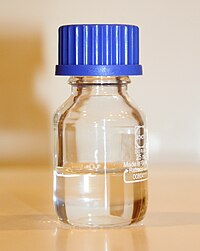
Photo from wikipedia
Electrocatalytic nitrogen reduction reaction (NRR) can realize the green production of ammonia while developing electrocatalysts with high selectivity and ability is still an ongoing challenge. Two-dimensional (2D) graphitic carbon nitride… Click to show full abstract
Electrocatalytic nitrogen reduction reaction (NRR) can realize the green production of ammonia while developing electrocatalysts with high selectivity and ability is still an ongoing challenge. Two-dimensional (2D) graphitic carbon nitride (CN) frameworks can provide abundant hollow sites for stably anchoring several transition metal (TM) atoms to facilitate single-cluster catalysis, promising to overcome the problems of low activity and poor selectivity in the process of ammonia synthesis. Herein, extensive density functional theory (DFT) calculations were performed to investigate the feasibility of six bimetallic triatomic clusters FexMoy (x = 1, 2; x + y = 3) supported on C6N6, C2N, and N-doped porous graphene (NG) as NRR electrocatalysts. Through a systematic screening strategy, we found that the Fe2Mo–NG possesses the highest activity with a limiting potential of –0.36 V through the enzymatic mechanism and could be the promising catalyst for NH3 synthesis. The Fe2Mo moiety in Fe2Mo–NG moderately regulates the electron transfer between reaction intermediates and NG, which is ascribed to enhanced performance. This work accelerates the rational design of catalysts in the field of NRR and contributes to broadening the understanding of cluster catalysis.
Journal Title: Catalysts
Year Published: 2023
Link to full text (if available)
Share on Social Media: Sign Up to like & get
recommendations!